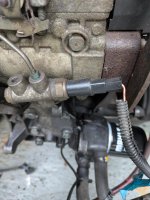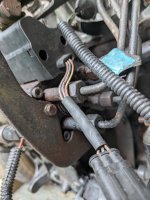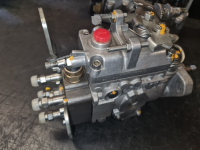I spent a couple of hours trying to get the engine to start today after the rebuild with the rebuilt head. I was pretty sure the main issue was timing.
I am confident I have the camshaft/crankshaft synchronised: if I move the camshaft 1 gear tooth either way on the cambelt, I can feel the pistons/valves meet when I hand crank.
I loosened the fuel pipe to cylinder number 1 and hand cranked – and I could see when a medium size drop of fuel appeared. It was consistent, so my plan was to get the timing such that this happened just at the end of the compression cycle.
As this bears no relationship to the marks on the fuel pump gear, it was a best-guess-exercise, trying one likely looking position, then tweaking by 1 gear etc.
Anyway, in the end, the engine started (!) which is always an exciting moment.
I had two issues:
Issue 1: I presume that when you turn the ignition key off, the engine should stop promptly? Is that correct? If so, I presume there is a solenoid that cuts the fuel (I have connected two sets of leads to the fuel pump, one on the side, one on the front)? Is there a reason why the engine might not stop immediately?
Issue 2: What are the likely causes of the clatter? Is this to be expected of a diesel engine of this age, or is this a sign of an issue e.g. timing. Does it need to be advanced or retarded?
any ideas appreciated
I am confident I have the camshaft/crankshaft synchronised: if I move the camshaft 1 gear tooth either way on the cambelt, I can feel the pistons/valves meet when I hand crank.
I loosened the fuel pipe to cylinder number 1 and hand cranked – and I could see when a medium size drop of fuel appeared. It was consistent, so my plan was to get the timing such that this happened just at the end of the compression cycle.
As this bears no relationship to the marks on the fuel pump gear, it was a best-guess-exercise, trying one likely looking position, then tweaking by 1 gear etc.
Anyway, in the end, the engine started (!) which is always an exciting moment.
I had two issues:
- As I have not connected up any of the coolant system (i.e. no coolant), I wanted the engine to stop before it got warm. When I removed the key, it carried on running. In a bit of a panic, I loosened the drain plug under the fuel filter. The engine did stop, but I don’t believe my action was the cause.
- The engine was loud and clattery.
Issue 1: I presume that when you turn the ignition key off, the engine should stop promptly? Is that correct? If so, I presume there is a solenoid that cuts the fuel (I have connected two sets of leads to the fuel pump, one on the side, one on the front)? Is there a reason why the engine might not stop immediately?
Issue 2: What are the likely causes of the clatter? Is this to be expected of a diesel engine of this age, or is this a sign of an issue e.g. timing. Does it need to be advanced or retarded?
any ideas appreciated
- Model
- ducato
- Year
- 1999
- Mileage
- 59000




